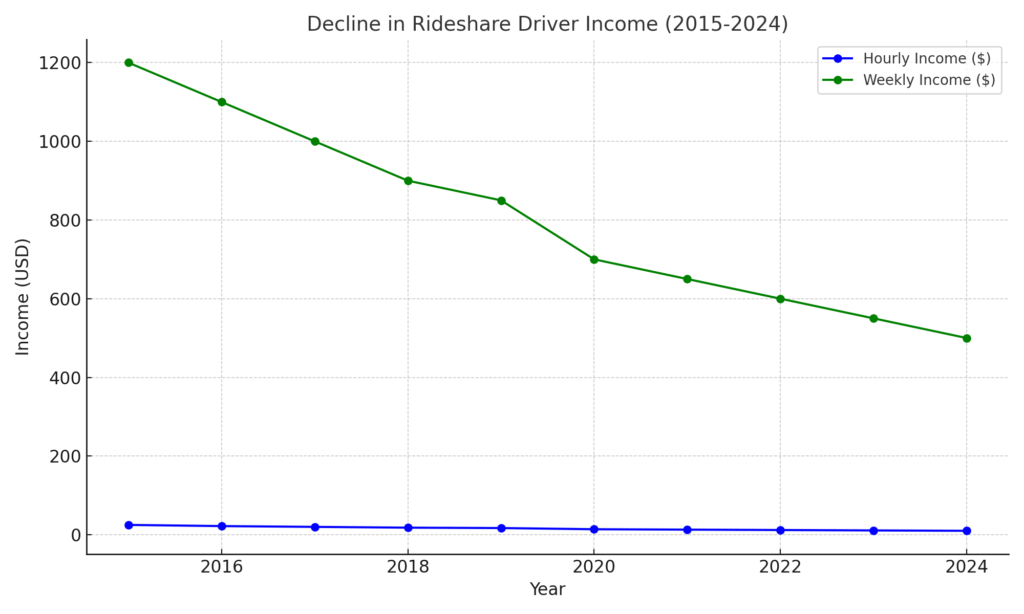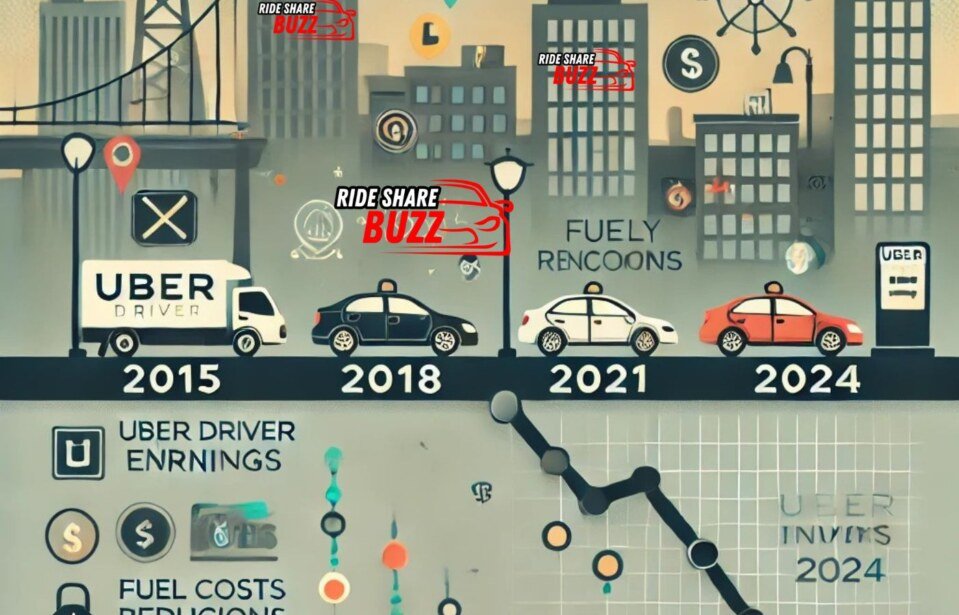The decline in rideshare driver income has become a significant issue for drivers, with a sharp reduction in earnings from 2015 to 2024. Although external factors such as rising operational costs have contributed to this decline, Uber’s fare reductions, commission structures, and operational changes have played a critical role. This article explores the timeline of rideshare driver income decline, how Uber has contributed to this issue, and how the decrease is affecting drivers on a personal and professional level.
2015: The Peak of Rideshare Earnings
In 2015, driving for Uber was lucrative. Drivers could earn between $20-$25 per hour, with full-time drivers making up to $1,200 per week. This flexibility and earning potential attracted a large number of drivers to Uber’s platform, which at the time offered solid financial rewards.
The Golden Era: Uber Driver Earnings in 2015
In 2015, Uber drivers enjoyed relatively high earnings as the platform was rapidly expanding, with fewer drivers and higher fare rates.
- Hourly Earnings: In many major cities like New York, Los Angeles, and San Francisco, drivers reported earning an average of $20-$25 per hour before expenses.
- Weekly Income: Full-time drivers, working around 40-50 hours a week, could earn $1,000-$1,200 per week before costs. This was before factoring in expenses such as gas, maintenance, insurance, and Uber’s commission.
For drivers, this was an attractive opportunity, offering both financial rewards and the freedom to work their own hours.
The Steady Decline Begins: 2016 to 2019
As Uber expanded globally and more drivers joined the platform, competition increased. With an oversupply of drivers, the company began reducing fares to attract more riders. While this benefited passengers, it began to chip away at driver earnings.
- Fare Reductions: To remain competitive and increase rider demand, Uber cut fares several times between 2016 and 2019. These fare cuts were sometimes as much as 30% in key markets like New York and San Francisco.
- Hourly Rate Decline: By 2019, the average hourly earnings for drivers had dropped to around $15-$20 per hour, with some markets seeing even lower rates.
- Weekly Income Decline: Full-time drivers who were once earning $1,000+ per week before expenses now found themselves making closer to $700-$900 per week before expenses, especially as competition grew and they had fewer rides per hour.
- Introduction of Cheaper Ride Options: The introduction of services like Uber Pool (where riders share rides with others headed in the same direction) and UberX (a cheaper version of the original Uber Black service) further reduced drivers’ per-trip earnings. While these services increased overall ride volume, the lower fares meant drivers had to work more hours to maintain their income levels.
- Increased Competition: More drivers meant fewer rides for each individual driver. During peak times, drivers found themselves waiting longer for trips, and during non-peak hours, there were simply too many drivers competing for too few passengers.
Impact of Rising Operational Costs
Even as Uber cut fares, the cost of operating a vehicle rose steadily. Many drivers faced higher costs for:
- Fuel Prices: Gasoline prices fluctuated, with significant increases in 2021 and 2022, particularly after the global economic disruptions during the COVID-19 pandemic. This severely impacted drivers who were already struggling with lower fares.
- Maintenance and Repairs: With drivers spending more hours on the road to make up for lower pay, their cars experienced more wear and tear. Maintenance costs, including tires, oil changes, and repairs, became a significant burden. Many drivers reported spending $200-$500 per month on upkeep.
- Insurance Costs: Rideshare insurance, which is often required for Uber drivers, added an extra monthly cost. In some areas, insurance could cost up to $200-$300 per month, further eating into driver profits.
- Uber’s Commission: Uber continued to take a significant percentage of each fare, typically between 25% and 30%, leaving drivers with less of the total fare earned.
The Pandemic Era: 2020 to 2021
The COVID-19 pandemic brought sudden and dramatic changes to Uber drivers’ income. For much of 2020, ridership plummeted as lockdowns and social distancing measures were put in place. Some key factors during this period included:
- Loss of Demand: For several months in 2020, Uber drivers found themselves with drastically reduced business. Many drivers left the platform during this period due to the uncertainty and safety concerns.
- Temporary Driver Shortages: In 2021, as lockdowns eased and demand began to pick back up, there was a temporary driver shortage. In some cities, Uber offered drivers bonuses or incentives to return to work, leading to a short-lived increase in earnings for those who did drive.
However, as more drivers returned and demand stabilized, the bonuses disappeared, and fares remained low, returning drivers to pre-pandemic income levels or worse.
2022 to 2024: Further Declines in Driver Earnings
By 2022, many drivers were dealing with both rising operational costs and stagnant or declining fares. Some of the key factors contributing to income declines during this period include:
- Rising Gas Prices: The surge in fuel prices in 2022 hit drivers particularly hard. While Uber introduced temporary fuel surcharges in some markets, these did little to offset the increasing cost of gas, and many drivers reported a further 10-20% drop in take-home earnings due to fuel expenses.
- More Fare Reductions: Despite rising costs for drivers, Uber continued to reduce fares in some markets to stay competitive with other rideshare services like Lyft, and to attract price-sensitive riders.
- Hourly Rate in 2024: By 2024, the average Uber driver’s hourly earnings had dropped to between $10-$15 per hour before expenses, a far cry from the $20-$25 per hour that was typical in 2015.
- Weekly Income in 2024: Full-time drivers, working 40-50 hours per week, now earn around $600-$800 per week before expenses. After accounting for gas, maintenance, insurance, and Uber’s commission, many drivers take home less than $500-$600 per week.
- Uber’s Commission Remains High: Despite fare reductions, Uber has kept its commission rates high. Many drivers report that Uber takes 25-30% of each fare, leaving them with less per ride.
Comparison of Driver Earnings: 2015 vs. 2024
| Year | Hourly Rate (Pre-expenses) | Weekly Income (Pre-expenses) |
|---|---|---|
| 2015 | $20-$25 per hour | $1,000-$1,200 per week |
| 2024 | $10-$15 per hour | $600-$800 per week |
| Decline | 40-50% | 33-50% |
What’s Next for Uber Drivers?
The future for Uber drivers remains uncertain. As costs continue to rise and fares remain low, many drivers are reconsidering whether the gig is worth the effort. Some have turned to other rideshare or delivery platforms, while others have left the industry entirely. For drivers who remain, maximizing income requires:
- Working Peak Hours: To increase earnings, many drivers now rely on working during peak hours or in surge zones, where demand is higher and fares are temporarily boosted.
- Maximizing Incentives: Some drivers try to maximize their earnings by taking advantage of Uber’s occasional bonuses or incentives for completing a certain number of rides.
- Cost Management: Many drivers focus on minimizing expenses, such as finding the cheapest gas, maintaining their cars efficiently, and selecting vehicles that are more fuel-efficient.
How Uber Contributed to the Decline in Driver Income
Over time, Uber implemented several policies that directly reduced driver income:
1. Fare Reductions
In an effort to compete with other rideshare platforms and attract more riders, Uber repeatedly lowered its fares. This benefited passengers but hurt drivers, as each trip generated less income.
- Impact on Drivers: Drivers had to complete more trips or work longer hours to earn the same amount they previously did, leading to exhaustion and less time for personal pursuits.
2. High Commission Fees
Uber’s commission structure remained unchanged despite fare cuts. The company typically takes between 25-30% of each fare, leaving drivers with a smaller share of their earnings.
- Impact on Drivers: High commissions combined with fare reductions meant that drivers’ take-home pay decreased significantly, forcing them to work more to make a sustainable income.
3. Introduction of Cheaper Ride Options
Uber launched services like UberX and Uber Pool, which offered more affordable rides to passengers. While these services increased overall demand, they drastically reduced per-trip earnings for drivers.
- Impact on Drivers: Drivers needed to handle more rides to reach the same income levels, further contributing to vehicle wear and tear and increasing operational costs.
4. Increased Competition
Uber onboarded large numbers of new drivers, which resulted in higher competition for the same pool of passengers.
- Impact on Drivers: More drivers on the road meant fewer ride requests per individual driver, leading to more downtime and less overall income.
5. Changes to Surge Pricing
Uber introduced caps on surge pricing, which had previously allowed drivers to earn more during high-demand periods. This change reduced the potential for extra earnings during peak times.
- Impact on Drivers: With limited surge pricing, drivers lost an important way to boost their income, leaving them with less opportunity to offset income losses from slower times.
6. Fewer Promotions and Bonuses
Initially, Uber incentivized drivers with numerous promotions and bonuses. However, these incentives have become less frequent and less rewarding over time.
- Impact on Drivers: Without the extra earnings from bonuses, drivers have become more dependent on their basic fare earnings, which have consistently decreased.
How the Decline in Driver Income Affects Drivers Personally
The decline in rideshare driver income is not just a financial issue. It has impacted drivers’ lives in many ways:
1. Financial Stress
Many drivers who relied on Uber as a full-time income source now struggle to meet their basic living expenses, such as rent, utilities, and groceries. With a 40-60% reduction in income since 2015, the financial strain is becoming unbearable for many.
- Effect: The need to work longer hours has increased, but the reduced hourly and weekly earnings make it difficult for drivers to cover their costs, let alone save for the future.
2. Increased Work Hours
As income dropped, many drivers extended their working hours to make ends meet. Some now work upwards of 10-12 hours per day, with little time left for family, rest, or personal life.
- Effect: Drivers suffer from burnout, physical exhaustion, and a lack of work-life balance.
3. Health Issues
Long hours behind the wheel have taken a toll on drivers’ physical and mental health. Many drivers experience back pain, fatigue, and stress due to the combination of increased work hours and financial pressure.
- Effect: Physical and mental health deterioration is becoming more common among drivers, leading to long-term wellness challenges.
4. Vehicle Maintenance Costs
As drivers take on more trips to make up for lost income, their vehicles endure more wear and tear. Maintenance and repair costs are now higher, and with less income, many struggle to keep their vehicles in good condition.
- Effect: Drivers face high maintenance costs that further eat into their reduced earnings, making the job less profitable and more financially stressful.
5. Job Insecurity
The decline in income and rise in competition has left drivers questioning their job security. What was once a promising source of income is now viewed as unsustainable for many drivers.
- Effect: Many drivers are looking for alternative work or additional jobs to supplement their Uber earnings, which adds more strain to their lives.
Rising Operational Costs and Their Impact on Income
In addition to Uber’s policies, operational costs for drivers have significantly increased, further reducing their net income.
1. Fuel Costs
Fuel prices have risen steadily, especially following global events like the COVID-19 pandemic and geopolitical tensions. This increase directly affects drivers’ take-home pay.
- Effect: Drivers now spend more of their earnings on fuel, which further reduces their already declining income.
2. Vehicle Maintenance
With more hours on the road, vehicles require more frequent repairs. Monthly maintenance costs can range from $200 to $500 depending on the vehicle and the wear and tear it experiences.
- Effect: Increased maintenance costs cut into drivers’ earnings, adding to the financial pressure they face.
3. Insurance Costs
Rideshare drivers often need specialized insurance, which is more expensive than regular auto insurance.
- Effect: High insurance premiums reduce the net earnings of drivers, making it harder to sustain a profitable career as an Uber driver.
Graph: Visualizing the Decline in Rideshare Driver Income (2015-2024)
The following graph illustrates the significant drop in both hourly and weekly income for rideshare drivers over the past decade. In 2015, drivers earned $25 per hour on average and made around $1,200 per week. By 2024, these numbers have dropped to $10 per hour and $500 per week, showcasing the sharp decline in driver earnings.

Table: Yearly Decline in Rideshare Driver Income (2015-2024)
The following table highlights the yearly decrease in hourly rate, weekly income, and the estimated number of hours a driver would need to work per week to reach that income. It also shows the percentage decrease in hourly rate and weekly income over time:
| Year | Hourly Rate ($) | Weekly Income ($) | Estimated Hours Worked | Hourly Rate Decrease (%) | Weekly Income Decrease (%) |
|---|---|---|---|---|---|
| 2015 | 25 | 1200 | 48 | 0.00% | 0.00% |
| 2016 | 22 | 1100 | 50 | 12.00% | 8.33% |
| 2017 | 20 | 1000 | 50 | 9.09% | 9.09% |
| 2018 | 18 | 900 | 50 | 10.00% | 10.00% |
| 2019 | 17 | 850 | 50 | 5.56% | 5.56% |
| 2020 | 14 | 700 | 50 | 17.65% | 17.65% |
| 2021 | 13 | 650 | 50 | 7.14% | 7.14% |
| 2022 | 12 | 600 | 50 | 7.69% | 7.69% |
| 2023 | 11 | 550 | 50 | 8.33% | 8.33% |
| 2024 | 10 | 500 | 50 | 9.09% | 9.09% |
How Many Hours Drivers Need to Work
As the table shows, a driver in 2015 could work approximately 48 hours a week to make $1,200, with an hourly rate of $25. However, by 2024, drivers must work 50 hours per week to earn $500 at an hourly rate of $10. Despite the steady number of work hours, the rideshare driver income has dropped drastically.
In 2020, drivers saw one of the steepest declines, needing to work the same 50 hours per week but earning just $700, compared to $1,200 in 2015.
By 2024, the cumulative effect is clear: even after working 50 hours, drivers are left with less than half of what they earned just a decade ago.
This continuous need to work longer hours for diminishing returns is one of the key stress points for drivers, as it affects not just their finances, but their health, work-life balance, and overall quality of life.
Conclusion: Uber’s Role in the Decline of Driver Income
From 2015 to 2024, rideshare driver income has decreased dramatically. While rising operational costs have contributed, Uber’s fare reductions, high commission fees, cheaper ride options, and surge pricing changes have had a direct impact.
The decline has left drivers with less income, forcing them to work longer hours, spend more on vehicle maintenance, and face increasing financial stress. Without significant changes from Uber, the future of rideshare driver income appears bleak, and drivers are left to navigate a more challenging and less rewarding environment.
Uber must reconsider its fare and commission structures if it wants to create a more sustainable system for its drivers. Without meaningful reform, drivers will continue to struggle to make ends meet, and many may leave the platform in search of better opportunities.





Leave a comment